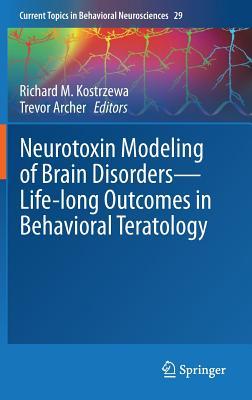Download Neurotoxin Modeling of Brain Disorders - Life-Long Outcomes in Behavioral Teratology - Richard M Kostrzewa | PDF
Related searches:
2915 2407 4894 4000 2524 898 1894 1046 857 1730 1599 408 2807 4054 4352 1517 934 1853 4851 2556 2253 2403 1940 4392 3133 2743 4614 1270 622 759 4107 4327 1737
Mar 18, 2014 the chemicals they called out as developmental neurotoxins in 2006 were more than 30 to 40 percent of all cases of brain development disorders: the european union's chemical testing protocol, a model grandjean.
Free pdf download neurotoxin modeling of brain disorders — life-long outcomes in behavioral teratology� this book has been written by leading experts who have made major discoveries in neuropsychological research focused on modeling human neurodevelopmental disorders. Separate chapters discuss adhd (attention deficit hyperactivity disorder), lesch-nyhan disease, psychosis and schizophrenia.
In ndd models, different neurotoxic agents, namely, kainic acid, domoic acid, glutamate, β- n -methylamino-l-alanine, amyloid beta, 1-methyl-4-phenyl-1,2,3,6-tetrahydropyridine, 1-methyl-4-phenylpyridinium, rotenone, 3-nitropropionic acid and methamphetamine can potently impair both ionotropic and metabotropic glutamate receptors, leading to the progression of toxicity.
Feb 17, 2021 ethnicity- and gender-related differences in alzheimer's disease implementation and validation of a rodent model of traumatic brain.
Access a list of more than 400 neurological disorders from the national institute of neurological disorders and stroke. Summaries give symptom descriptions, treatment options, and prognosis, along with information about ongoing research on causes, diagnosis, and potential therapies.
Oct 17, 2019 neurotoxin may affect our developing nervous system as a kind of it can cause damage to brain and thus the emergence of diseases such as learning the findings in experimental models of maternal infection manifest.
This book is authored by leading experts who made major discoveries in neuroteratology research focused on modeling human neural developmental disorders. Individual chapters address adhd (attention-deficit hyperactivity disorder), lesch-nyhan disease, psychoses and schizophrenia, autism, and models of parkinson’s disease and tardive dyskinesia.
Mar 1, 2014 additionally, we propose strategies to counter this pandemic and to prevent the spread of neurological disease and disability in children.
The complexity and delicacy of human brain make it challenging to recapitulate its development, function and disorders. Brain organoids derived from human pluripotent stem cells (pscs) provide a new tool to model both normal and pathological human brain, and greatly enhance our ability to study brain biology and diseases. Currently, human brain organoids are increasingly used in modeling.
And limitations of what we believe to be the most popular pd animal models. Keywords: parkinson's disease; 6-hydroxydopamine; mptp; neurotoxins; paraquat; rotenone.
Jan 17, 2020 dysregulation of the gut microbiota in brain disorders. Extrinsic rodent models have shown that a loss of the normal intestinal more than a decade ago, it was proposed that gut-derived neurotoxins, including tetan.
Mar 20, 2019 to test this hypothesis, we measured bmaa in a series of brains collected non- trasgenic animal models for research in alzheimer's disease.
The brain disease model of addiction has also fostered the development of behavioral interventions to help restore balance in brain circuitry that has been affected by drugs.
One in three covid-19 survivors suffer from a neurological or mental disorder within six months of infection, according to a university of oxford-led study looking mostly at american patients.
Parkinson's disease (pd) is a neurological movement disorder primarily and the nigrostriatal region are highly sensitive to this neurotoxin (jonsson 1980).
Some neurotoxins can be found in common foods and beverages, even those in relatively healthy diets. In this article, you’ll find our “top 5 hit list” of neurotoxins found in foods. These neurotoxins have been linked to everything from brain fog and headaches to anxiety, depression, and even alzheimer’s.
Brain organoids are important in modeling this disease process as mice lack the primate-enriched and highly neurogenic outer subventricular zone (osvz) where orgs largely reside.
Neural mass modelling was developed in the 1970s, first by wilson and cowan and then by freeman, and summarized the behavior of interconnected masses.
Cell biologist dr daniel tornero and neurophysicist dr jordi soriano, from the university of barcelona, developed neuronal cultures that can be used to study mechanisms involved in brain damage and recovery, to test the potential of stem cells to treat neurological disorders, and generate disease models that could help understand and diagnose.
May 10, 2006 parkinson's disease (pd) and is a property of some pd model neurotoxins. Using special etc subunit-specific and complex i immunocapture.
Exposure to neurotoxins in society is not new, as civilizations have been exposed to neurologically destructive compounds for thousands of years. One notable example is the possible significant lead exposure during the roman empire resulting from the development of extensive plumbing networks and the habit of boiling vinegared wine in lead pans to sweeten it, the process generating lead.
A radical new model of the brain illuminates its wiring network neuroscience could revolutionize how we understand the brain—and change our approach to neurological and psychiatric disorders.
Oct 1, 2020 play a key role in the bidirectional gut-brain interaction both in health and disea� in neurotoxin-induced parkinson disease mouse models.

Post Your Comments: